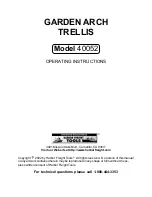
55
New Brunswick Scientific
User’s Guide
9.
After sterilization is 100% complete the operator should place the sparge
valve back into the sparge position by pulling the valve ring out, pushing
the sparger tube back down as far as it will go, then releasing the valve
ring.
8.2.4
Resetting Sterilization Parameters
#
NOTE
:
The sterilization parameters have been preconfigured at the factory. The
operator may make changes to the sterilization parameters by following
the instructions below.
The user-definable sterilization parameters are shown in Figure 31, which is a
detail from the
STERILIZATION
screen shown in Figure 22. They are further
explained in Table 5, which follows the illustration.
Figure 31: Automatic Sterilization Parameters
Summary of Contents for BioFlo 415
Page 12: ......
Page 129: ...117 New Brunswick Scientific User s Guide Figure 65a Controller Schematics left side ...
Page 130: ...118 BioFlo 415 y M1360 0050 User s Guide Figure 65a Controller Schematics right side ...
Page 145: ...133 New Brunswick Scientific User s Guide ...
Page 146: ...134 BioFlo 415 y M1360 0050 User s Guide ...
Page 147: ...135 New Brunswick Scientific User s Guide ...
Page 148: ...136 BioFlo 415 y M1360 0050 User s Guide ...
Page 149: ...137 New Brunswick Scientific User s Guide ...
Page 150: ...138 BioFlo 415 y M1360 0050 User s Guide ...
Page 151: ...139 New Brunswick Scientific User s Guide ...
Page 152: ...140 BioFlo 415 y M1360 0050 User s Guide ...
Page 153: ...141 New Brunswick Scientific User s Guide ...
Page 154: ...142 BioFlo 415 y M1360 0050 User s Guide ...
Page 155: ...143 New Brunswick Scientific User s Guide ...
Page 156: ...144 BioFlo 415 y M1360 0050 User s Guide ...
Page 157: ...145 New Brunswick Scientific User s Guide ...
















































